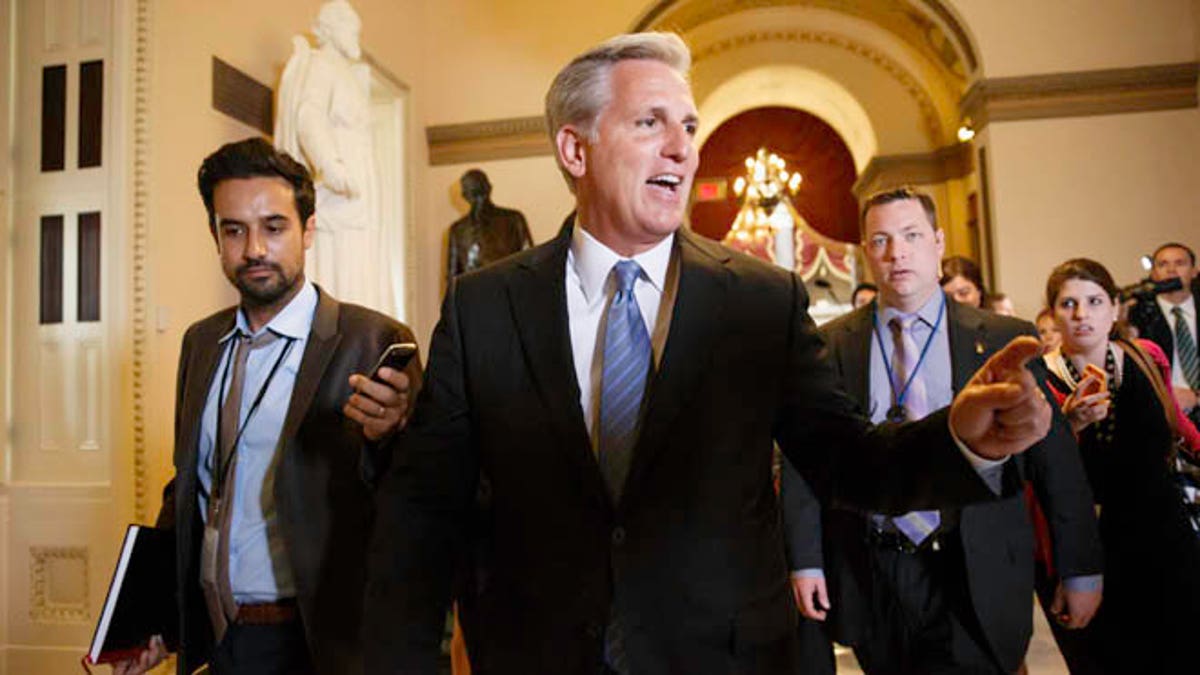Now that a divided Senate has voted to move forward with the Republicans' long-promised legislation to repeal and replace ObamaCare, here's what to keep in mind about the health care bill's state of play:
1) Math is always critical on Capitol Hill. That was never better exemplified than when Sen. John McCain, R-Arizona, suffering from brain cancer, trekked back across the country to make today’s procedural vote.
McCain’s presence -- and yes vote -- gave the GOPers 50 yeas on the motion to proceed and start debate on the bill. Had McCain not been there, the vote would have been 49 GOP yeas and 50 Democratic noes. That would have killed the effort right there.

FILE - In this July 11, 2017 file photo, Senate Armed Services Committee Chairman Sen. John McCain, R-Ariz. listens on Capitol Hill in Washington, during the committee's confirmation hearing for Nay Secretary nominee Richard Spencer. Surgeons in Phoenix said they removed a blood clot from above the left eye of McCain. Mayo Clinic Hospital doctors said Saturday, July 15 that McCain underwent a "minimally invasive" procedure to remove the nearly 2-inch (5-centimeter) clot, and that the surgery went "very well." They said the 80-year-old Republican is resting comfortably at his home in Arizona. Pathology reports are expected in the next several days. (AP Photo/Jacquelyn Martin, File) (AP)
McCain’s presence produced the tie, thus enabling Vice President Pence to break the tie, 51-50.
Interestingly, the Senate is using a special process for health care to sidestep a Democratic Senate filibuster, which can only be overcome by 60 votes. But the problem wasn’t with Democrats. Republicans were barely able to scrape together enough votes from their own side of the aisle just to start debate on the legislation.
2) Math is always critical on Capitol Hill Redux. That was never better exemplified by the fact that Pence had to break the tie.
Yes. Fifty senators may have voted to start debate. But as McCain predicted in his speech, getting 51 yeas for this bill, or even 50 so they can again turn to Pence, is problematic. The bill can’t shift too far to the right or left. It’s fragile enough as it is.
It seems as though they may never be able to get Sen. Susan Collins, R-Maine, to vote yea. Unclear about Sen. Lisa Murkowski, R-Alaska. But Murkowski is more in play than Collins.
Even so, Republicans are already down one. Keep eyes on Sens. Mike Lee, R-Utah, Rand Paul, R-Ky., and Ted Cruz, R-Texas, on the right -- and Sens. Dean Heller, R-Nev., Jeff Flake, R-Arizona, John McCain, R-Arizona, John Hoeven, R-N.D., Shelley Moore Capito, R-W.V., Ron Johnson, R-Wis., Rob Portman, R-Ohio, and some others in the coming days.
This is the problem that they had with the House health care bill. They fixed one problem for the conservatives and they simultaneously created another problem with the moderates.

El líder de los republicanos en el Senado, Mitch McConnell, sonríe tras una reunión de su bancada legislativa en el Capitolio en Washington, el jueves 22 de junio del 2017. (AP Foto/Andrew Harnik) (AP)
The turning radius is more narrow in the Senate than in the House. That’s why the margin for error is virtually nil. It will represent a Herculean effort if Senate Majority Leader Mitch McConnell, R-Ky., can hold everyone together and not lose more than two votes.
3) Vocabulary terms: Budget Reconciliation, Points of Order, Waive the Budget Act, “Vote-a-rama.” You will hear these a lot over the next few days.
The Senate is using “budget reconciliation” to debate the health care bill. Budget reconciliation limits amendments and debate -- nothing else -- to 20 hours.
The advantage of using budget reconciliation is that it turns off filibusters, provided you have everyone on your own side of the aisle in order.
Points of Order are grievances a senator may lodge against a bill if he or she doesn’t feel the Senate is operating within its rules or “budget reconciliation.” However, the Senate can vote to “waive the Budget Act” -- which created budget reconciliation -- with 60 yeas.
“Vote-a-rama” is where they cobble all of the votes on amendments, points of order, et al together in a chunk. The Senate may vote for hours on end, just one vote after another.
4) Expect long days/nights in the Senate this week, with a final vote, pass or fail, late Thursday or after midnight Friday. ‘Nuff said.
5) What about the House if the Senate approves a health care bill? Fox News is told there is no plan yet to keep the House here past Friday, the scheduled start of the August recess.

In this photo taken June 11, 2014, House Majority Whip, Republican Kevin McCarthy of Calif., leaves House Speaker John Boehner's office on Capitol Hill in Washington. Emboldened conservatives are promising to make themselves heard on Capitol Hill like never before in the wake of Majority Leader Eric Cantor's surprise defeat to an unknown with tea party backing. That sets up the potential for struggles over Congress' most basic legislative responsibilities and dooms whatever slim hopes remained for ambitious bills on immigration or voting rights. (AP Photo/J. Scott Applewhite) (AP)
A senior House leadership aide tells Fox News it will evaluate what the Senate has approved -- if something is approved -- and determine if the House needs to come back in August. House Majority Leader Kevin McCarthy, R-Calif., told members he reserves the right to recall the House within a 72-hour period.
Also, if the House and Senate have approved differing versions of health care, it may take weeks or months to resolve the differences.
Case in point: The House approved the original version of ObamaCare in November, 2009. The Senate approved its version of ObamaCare in December, 2009. The House and Senate then took until late March, 2010 to merge the bills into one and send a final, unified product to the president’s desk.





